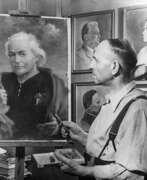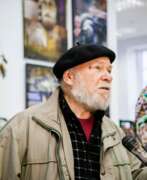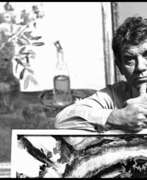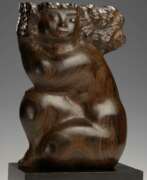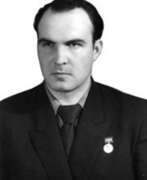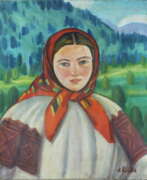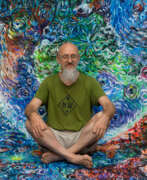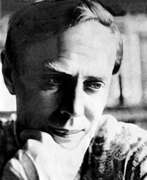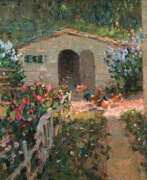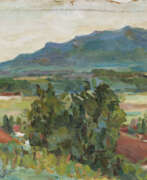Ukraine Contemporary art


Alexander Grigorievich Maksymenko (Russian: Александр Григорьевич Максименко) was a Soviet and Ukrainian painter of the second half of the twentieth and early twenty-first centuries. He is known as a painter, graphic artist, watercolorist, and art historian.
Alexander Maksymenko worked in the genres of still life, landscape, portrait, as well as in genre painting. His genre works cover themes of collective farm life, including "Masters of the Land" and "Innovators of Collective Farm Fields". For the latter work he received the Stalin Prize. The master actively participated in exhibitions in Ukraine and abroad. His works are in the National Art Museum of Ukraine, the Museum of the History of Ukraine in World War II, as well as in other art museums and private collections.


Taisia Kirillovna Afonina (Russian: Таисия Кирилловна Афонина) was a Soviet artist of the second half of the twentieth century. She is known as a painter, graphic artist, representative of the Leningrad school.
Taisia Afonina participated in exhibitions since 1940, creating portraits, landscapes, genre compositions, still lifes and etudes. At the beginning of her career she was interested in military subjects, and then delved into the genre of portraiture and lyrical landscape. Her style is characterized by tonal painting, the rendering of light and air environments and subtle coloristic combinations. In the 1980s she preferred the watercolor technique, painting flowers such as roses, daisies and tulips. Her works are in museums and private collections in Russia and other countries.
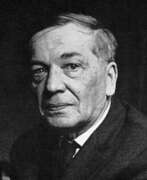

Mikhail Fedorovich Andrienko-Nechytailo (Russian: Михаил Фёдорович Андриенко-Нечитайло) was a Russian artist known for his contributions to the avant-garde movement. Born in 1894, he became renowned for his innovative approach to painting, stage design, and illustration. Andrienko-Nechytailo’s work is celebrated for its unique blend of Constructivism and Cubism, which set him apart from his contemporaries.
One of his special features was his ability to combine geometric forms with a vibrant color palette, creating visually striking compositions that challenged traditional artistic conventions. His works often explored themes of abstraction and the intersection of art and technology. His notable pieces are housed in prestigious collections, including the Tretyakov Gallery in Moscow and the Russian Museum in Saint Petersburg.
Collectors and art experts admire Andrienko-Nechytailo for his visionary approach and lasting impact on modern art. His legacy continues to influence contemporary artists and is a testament to his skill and creativity.
Sign up for updates on new product sales and auction events related to Mikhail Fedorovich Andrienko-Nechytailo. Stay informed about opportunities to add his remarkable works to your collection.


Vladislav Leopoldovich Anisovich (Russian: Владислав Леопольдович Анисович) was a Soviet artist of the mid-twentieth century. He is known as a painter, graphic artist and teacher, a representative of the Leningrad school of painting.
Vladislav Anisovich participated in various exhibitions since 1935. His work included portraits, historical and genre compositions, as well as landscapes. Among the famous paintings of the artist are "The passage of K. Voroshilov's detachment from Lugansk to Tsaritsyn", "Assault on Perekop" and others. The master taught at the Leningrad Institute of Painting, Sculpture and Architecture.
His works are in various museums and private collections in many countries, including the State Russian Museum.


Vladimir Davidovich Baranov-Rossine (Russian: Владимир Давидович Баранов-Россине) was a master of the Russian avant-garde, a prolific painter, sculptor, and inventor, whose work significantly contributed to the Cubo-Futurism movement. Born on January 1, 1888, in Kherson, he was originally named Shulim Wolf Leib Baranov but is best known by his pseudonym, Daniel Rossine. His early artistic education took place in Odessa and then at the St. Petersburg Academy of Arts, laying the groundwork for his future as a revolutionary artist.
In 1910, Baranov-Rossine moved to Paris, a pivotal move that introduced him to the burgeoning European avant-garde scene. It was there, alongside other notable artists such as Marc Chagall, Osip Zadkine, Alexander Archipenko, and Chaim Soutine, that he became an inhabitant of the famous Parisian house "La Ruche." His innovative work, particularly the invention of the Optophonic Piano, which projected colors in sync with music, underscored his commitment to blending art and technology, a hallmark of his career.
Tragically, Baranov-Rossine's life was cut short when he was arrested by the Gestapo in 1943 and subsequently died in Auschwitz in 1944. Despite his untimely death, his legacy lives on through his contributions to modern art and technology. His works can be found in various museums and galleries, celebrated for their vibrant expression and avant-garde techniques that continue to inspire artists and collectors alike.
For those intrigued by Vladimir Davidovich Baranov-Rossine's pioneering work and its lasting impact on the art world, signing up for updates on new product sales and auction events related to this avant-garde master is highly recommended. This ensures enthusiasts and collectors are always informed about the latest opportunities to engage with Baranov-Rossine's remarkable legacy.


Victoria Markovna Belakovskaya (Russian: Виктория Марковна Белаковская) was a Russian Soviet artist of the mid-twentieth century. She is known as a painter, graphic artist and representative of the Leningrad school of painting.
Victoria Belakovskaya participated in exhibitions of Leningrad artists since the early 1930s. Her work covers various genres, including portraits, genre compositions, still lifes and landscapes. Her famous works include "Pioneer Girl" (1931), "Self-Portrait with a Cigarette" (1936), "Leningrad Landscape" (1953), "Spring Flowers. Still Life" (1961), a series of landscapes of Altai, Crimea, Kiev and others.
Works by the artist are in the collections of museums in Russia, Great Britain, USA, France and other countries.


Kateryna Vasilyevna Belokur (Russian: Екатерина Васильевна Белокур) was a Ukrainian Soviet artist of the mid-twentieth century. She is known as a master of folk decorative painting.
Kateryna Belokur was self-taught and became famous for her colorful paintings, mostly depicting flowers, landscapes, and portraits. Her work often included a combination of spring and fall elements, and she could take weeks to create even small details on canvas. Catherine also made her own brushes, selecting hairs from cattails, and used a separate brush for each paint. Her work was characterized by vibrant colors and style.


Vilmos-József Istvanovich Berets (Russian: Вильмош-Йожеф Иштванович Берец) was a Ukrainian Soviet artist of the second half of the twentieth century of Hungarian origin. He is known as a painter, graphic artist, teacher, and art historian.
Berets created works mainly in easel graphics, among his most outstanding works are watercolor landscapes. Since 1950 he actively participated in art exhibitions. He was also the author of articles on the theory of art, as well as studies on various artists, including the work of Transcarpathian artists, in the course of which the master collected extensive archival material on the history of the local school of painting.


Georgy Nikolaevich Bibikov (Russian: Георгий Николаевич Бибиков) was a Russian and Soviet artist of the mid-20th century. He is known as a painter, graphic artist, illustrator, muralist and theater artist of the Leningrad school, working in the genres of landscape, portrait, still life and thematic painting.
Georgy Bibikov began participating in art exhibitions in 1920. Among his famous works are "Loaders", "Young Red Fleets Receive Uniforms", "Greetings to the Winners", "Trench Truth" and others. His works are in the State Russian Museum and in museums and private collections in Russia, Ukraine, Germany and France.


Moses Abramovich Blank (Russian: Моисей Абрамович Бланк) was a Ukrainian Soviet artist of the mid-twentieth century. He is known as a painter and graphic artist, distinguished for his still lifes and landscapes.
Moses Blank actively participated in art exhibitions, including national, all-Union and international exhibitions, beginning in 1927. He used various artistic techniques including lithography, etching, ink, watercolor, gouache, pastel, and sometimes oil. During the Great Patriotic War he voluntarily went to the front, after the war he served as an artist in the Air Defense Corps in Riga. The master left a noticeable trace in the history of art in Ukraine.


Nikolay Stepanovich Borovsky (Russian: Николай Степанович Боровский) was a Soviet Ukrainian artist of the second half of the twentieth century. He is known as a painter and teacher.
Nikolay Borovsky became famous for his portraits, landscapes and still lifes, as well as genre paintings. Some of his works were characterized by extraordinary realism. Since the early 1960s, he actively exhibited his works and in 1964 joined the Union of Artists of the USSR. For his painting "Worker. Year 1928" he received the prize of the Union of Artists of the Ukrainian SSR.
The master created a significant number of works that are in private and public collections, including a gallery of portraits of participants in the defense and liberation of Dnepropetrovsk.
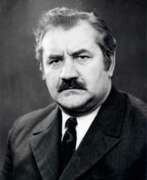

Nikolai Yakovlevich Bout (Russian: Николай Яковлевич Бут) was a Soviet artist of the second half of the twentieth century. He is known as a painter and graphic artist, a master of the battle genre.
Nikolai Bout began painting from his teenage years and immediately showed an interest in depicting historical battles. Throughout his career as a professional artist, he lived in Moscow, and spent the summer months in Kerch, where the subjects of many of his paintings originated. He painted portraits, battle and genre paintings, and landscapes. His works include the cycle "Adzhimushkay. 1942", series of paintings "Slovak National Uprising", "Heroic Marines" and other works.
Bout was an artist of the M. B. Grekov Studio of Military Artists since 1958.
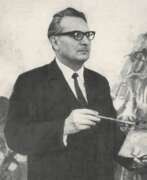

Alexander Gavrilovich Budnikov (Russian: Александр Гаврилович Будников) was a Soviet Ukrainian artist of the twentieth century. He is known as a battle painter.
During the Great Patriotic War Alexander Budnikov worked for a frontline newspaper, created posters and sketches from the battlefields. After the war he studied at the Kiev Art Institute, later became a teacher and professor at this institution. The artist worked in the genre of battle painting, and was also the author of a series of landscapes from different countries. His works are kept in museums in Ukraine, Russia and in private collections in Europe, the USA and Canada.


Vasily Dmitrievich Chegodar (Russian: Василий Дмитриевич Чегодар) was a Soviet and Ukrainian artist of the second half of the twentieth century. He is known as a painter who worked in the genres of landscape and still life.
Vasily Chegodar gained recognition by starting to participate in art exhibitions since 1942. An important period in his work was the 1950s, when he fully devoted himself to painting and became known for his Kiev landscapes. The artist left a rich creative legacy, including about ten thousand paintings and graphic works, some of which are in private collections in Ukraine, Russia and Europe.


Leonid Ivanovich Chernov (Russian: Леонид Иванович Чернов) was a Soviet Ukrainian artist of the second half of the twentieth century. He is known as a painter, graphic artist and teacher.
Leonid Chernov created in various genres, including landscape, still life and genre painting. He has participated in numerous exhibitions since 1945. His work was inspired by business trips to India, Afghanistan, Bulgaria and Cuba. Notable works include cycles of landscapes "Across Ukraine", etchings "In Folk Bulgaria", drawings dedicated to Ukrainian folk songs and poems by Soviet poets.
Chernov nurtured a galaxy of Ukrainian artists and played an important role in the development of the Ukrainian art community.


Ivan Ivanovich Chorny (Russian: Иван Иванович Чёрный) was a Soviet, Ukrainian and Russian artist of the second half of the twentieth and early twenty-first centuries. He was known for his monumental and decorative works in the style of socialist realism.
Ivan Chorny reoriented his style in the late 1990s, inventing a new technique and moving away from figurativeness in favor of abstract painting. His enigmatic compositions became an expressive expression of inner feelings enriched with colors and lines.


Stefan Ivanovich Florescu (Russian: Степан Иванович Флореску) was a Soviet and Moldovan artist of the second half of the twentieth and early twenty-first centuries. He is known as a painter, graphic artist and inventor who solved complex artistic problems using the methodology of the theory of inventive problem solving.
Starting in art at a young age, Stefan Florescu sought to develop not only his knowledge but also his skills as a portrait painter, exploring the complex aspects of human nature. His work encompassed various genres, including thematic compositions, landscapes, still lifes and portraits, as well as utilizing a variety of artistic and technical methods to create expressive images.
During his career, the master created more than 10,000 sketches, sketches, and sketches; about 250 graphic works; more than 390 pictorial compositions; and two sculptural projects.


Albin Stanislavovich Gavdzinsky (Russian: Альбин Станиславович Гавдзинский) was a Soviet and Ukrainian artist of the second half of the twentieth and early twenty-first centuries. He is known as a painter, famous for his landscapes, genre paintings and portraits.
Albin Gavdzinsky in the early 1950s held his first solo exhibitions in Odessa, Kiev and Kharkov and showed his bright artistic personality. The artist was distinguished by his outstanding efficiency and precision in depiction, which was evident in his clear forms and bright colors. In 1961 he was recognized as Honorary Citizen of the city of Novaya Kakhovka, and his works (237 canvases) served as the basis for the creation of the city's art gallery, which in 2003 was named after him.


Grigory Ivanovich Gavrilenko (Russian: Григорий Иванович Гавриленко) was a Ukrainian Soviet artist of the mid-twentieth century. He is known as a graphic artist and illustrator, a representative of Ukrainian avant-garde art, a "sixties" artist.
Grigory Gavrilenko became famous for his graphic works, including landscapes and portraits. His work included a variety of techniques and styles, from quick sketches to laconic drawings-formulas. The master also designed and illustrated many books, including folk tales. In the last years of his life, he worked extensively in color linocuts, creating prints and illustrations.


Valery Arutyunovich Geghamyan (Russian: Валерий Арутюнович Гегамян) was a Soviet and Ukrainian artist of the mid-twentieth century of Armenian origin. He is known as a painter, graphic artist and teacher.
Valeriy Geghamyan became famous for his monumental canvases, large thematic cycles and graphic series. He also created portraits, landscapes and still lifes. Since the early 1960s he lived and worked in Odessa and founded the art and graphic arts faculty at the Odessa Pedagogical Institute, where he taught for more than 20 years. The master raised many famous artists, some of whom are also teachers, passing on the experience of their teacher.


Herman Moiseyevich Gold (Russian: Герман Моисеевич Гольд) is a Soviet, Ukrainian and contemporary Israeli artist. He is known as a painter, draftsman, and watercolorist, renowned for his expressive style of painting.
Herman Gold is skilled in both oil painting and watercolor, and often gives his works a dramatic character. He is one of the few contemporary Jewish artists to be included in the legendary World Encyclopedia of Artists of All Time.
His works are in museums and galleries in many countries, including Russia, Ukraine, France, Greece, the United States and others.
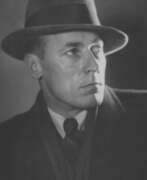

Jazep Mikhailovich Gorid (Russian: Язеп Михайлович Горид) was a Belarusian and Polish-Lithuanian artist of the first half of the twentieth century. He is known as a graphic artist and painter, caricaturist and illustrator.
Jazep Gorid drew political and everyday caricatures, painted portraits and landscapes. He also worked in book graphics, illustrated and designed books and other printed publications. In addition, the artist created stained-glass windows and murals.


Pavel Matveyevich Gorobets (Russian: Павел Матвеевич Горобец) was a Soviet Ukrainian artist of the mid-twentieth century. He is known as a painter, landscape painter who worked early in his career as an artist-journalist.
Pavel Gorobets became famous for the lyrical style of his landscapes depicting the nature of Poltava region. His works are characterized by subtle lyricism, penetration and deep affection for his native nature. Critics called the artist a "master of landscape miniature". His works are in museums of various Ukrainian and Russian cities, as well as in private collections.


Mykola Petrovich Hlushchenko, a prominent Ukrainian post-impressionist painter, was born in 1901 in Novomoskovsk, Russia, and is celebrated for his diverse artistic contributions that span across various European landscapes, still life, nudes, and notable portraits. His early exposure to art in Yuzivka (now Donetsk), and further education at the Academy of Art in Berlin in 1924, laid the foundation for his illustrious career. Hlushchenko's work caught the attention of French critics soon after he moved to Paris in 1925, marking his transition from the New Objectivity style to post-Impressionism.
Hlushchenko's involvement with the Association of Independent Ukrainian Artists in the early 1930s, and his exhibitions across major European cities and the United States, underscored his role as a leading figure in Ukrainian post-impressionism. His work was characterized by vibrant color use and a unique blend of styles influenced by his time in Germany, France, and later in the Soviet Union. Throughout his life, Hlushchenko's art reflected his extensive travels and deep appreciation for landscapes, earning him numerous awards including the Shevchenko National Prize in 1972.
For art collectors and enthusiasts, Hlushchenko's pieces not only represent the zenith of Ukrainian post-impressionism but also embody the artist's rich, multifaceted life experiences. His paintings, such as the portraits of Oleksandr Dovzhenko and Volodymyr Vynnychenko, along with commissioned works for the Soviet government, showcase his adaptability and mastery over his medium.
To stay informed on Mykola Petrovich Hlushchenko's works and related auction events, signing up for updates is advisable. This subscription ensures you're always in the loop for new sales and exhibitions, enriching your collection with the vibrant legacy of a distinguished Ukrainian artist.


Alexander Mikhailovich Kishchenko (Russian: Александр Михайлович Кищенко) was a Soviet and Belarusian artist of the second half of the twentieth century. He is best known as a muralist painter.
Alexander Kishchenko is considered one of the most famous artists of Belarus of the 20th century, and his works are valuable assets of Belarusian culture. He worked in all genres of easel and monumental decorative painting and created hundreds of works during his career, including philosophical paintings and portraits. The artist was also proficient in mosaics, ceramics and tapestry.


Ernest Rudolfovich Kontratovich (Russian: Эрнест Рудольфович Контратович) was a Ukrainian and Soviet artist of the twentieth and early twenty-first centuries. He is known as a painter, teacher, one of the founders of the Transcarpathian school of painting.
Ernest Kontratovich developed his own direction of expressionism, reflecting the themes of nature, folklore and folk life of Transcarpathia. His works include landscapes and genre paintings. He was also one of the founders of the Transcarpathian Art Gallery. His paintings are kept in museums, galleries and private collections in Ukraine, Slovakia and Russia.


Olga Yurievna Kotlyarova-Prokopenko (Russian: Ольга Юрьевна Котлярова-Прокопенко) is a Soviet and contemporary Ukrainian artist. She is known as a painter and public figure, Honored Artist of Ukraine and member of the National Union of Artists.
Olga Kotlyarova-Prokopenko works in oil painting and watercolor techniques with a focus on landscapes, still lifes and portraits. Since beginning her career in 1977, she has participated in over 600 exhibitions, including 63 solo exhibitions. Her works are in many galleries in Ukraine and abroad, as well as in private collections in many countries, including France, Germany, USA and Spain. The artist holds a vice-presidential position in the Union of Marinists of Odessa and was awarded the Order of Princess Olga III degree.


Konstantin Matveyevich Lomykin (Russian: Константин Матвеевич Ломыкин) was a Soviet and Ukrainian artist of the second half of the twentieth and early twenty-first centuries. He is known as a painter and graphic artist, People's Artist of the Ukrainian SSR.
Since 1951 Konstantin Lomykin actively participated in various exhibitions both in the USSR and abroad. His work covers a variety of genres, including thematic painting, portrait, landscape and still life. One of his most famous works was the painting "Bogdan Khmelnitsky's Oath over the Body of a Tortured Cossack", presented at the Republican Exhibition in 1954.
Lomykin's works can be found in art museums in Ukraine, as well as in private collections in various countries, including Japan, France, Greece, Germany, Italy and Portugal.

Victor Mikhailovich Malyi (Russian: Виктор Михайлович Малый) is a Soviet and contemporary Russian artist. He is known as a painter and teacher, Honored Art Worker of Russia.
Victor Malyi as a painter specializes in the genres of landscape and still life. His artistic career began with a major exhibition "Soviet South" in 1967. For his contribution to art, he was awarded many certificates, diplomas and badges of honor from various organizations and departments.
His works are in museums, private collections and galleries both in Russia and abroad. Since 1976, he has also taught painting at the Surikov Moscow State Academic Art Institute and is a professor at this institution.


Gavriil Kondratyevich Malysh (Russian: Гавриил Кондратьевич Малыш) was a Soviet and Russian artist of the second half of the twentieth century. He is known as a painter and watercolorist, a representative of the Leningrad school.
Gavriil Malysh worked mainly in the genres of landscape, still life and genre compositions. He became famous as a bright watercolorist, a master of lyrical landscape and decorative still life. His works are distinguished by a color palette dominated by blue, lilac and violet tonalities. His works are in numerous museums and private collections in Russia and other countries, including France, USA, Japan and Italy.


Anton Ivanovich Manastyrsky (Russian: Антон Иванович Манастырский) was a Ukrainian and Soviet artist of the twentieth century. He is known as a painter and graphic artist.
Anton Manastyrsky became famous for his genre paintings based on Ukrainian folk songs. His works are characterized by plasticity, rhythm and poetry. He also worked in the portrait genre, creating such canvases as "Portrait of Mother", "Portrait of Taras Shevchenko" and others. The master also illustrated books and worked in the religious genre, restoring the iconostasis in the Church of the Assumption of the Blessed Virgin Mary in Ancient Galich.


Vitold Antonovich Manastyrsky (Russian: Витольд Антонович Манастырский) was a Ukrainian and Soviet artist of the second half of the twentieth century. He is known as a painter, graphic artist, teacher, and son of the artist Anton Manastyrsky.
Vitold Manastyrsky created many works, including genre paintings, portraits, landscapes and still lifes. In his works he reflected the beauty of the Pre-Carpathian region, the life of its inhabitants, as well as portrayed his contemporaries - workers, peasants and cultural figures. He was active both creatively and in public and pedagogical spheres, he was often elected to the governing bodies of the Union of Artists of Ukraine. Many of his works are exhibited in Ukrainian museums and galleries.


Leonid Yakovlevich Mezheritski (Russian: Леонид Яковлевич Межерицкий) was a Soviet, Ukrainian and Israeli artist of the second half of the twentieth and early twenty-first centuries. He is known as a painter who specialized in oil painting, a representative of the South Russian (Odessa) school.
Leonid Mezheritski created mainly plein air landscapes, and also worked in the genres of portraiture and still life. His style was based on the coloristic systems of French Impressionism and Post-Impressionism. His works can be found in state art museums in Ukraine and private collections in various countries, including the United States, Canada, Germany, England, Israel and Russia.


Georgy Moiseevich Moroz (Russian: Георгий Моисеевич Мороз) was a Soviet and Russian artist of the second half of the twentieth and early twenty-first centuries. He is known as a painter, a representative of the Leningrad school, whose work included landscapes, still lifes, genre compositions and portraits.
Georgy Moroz, having started participating in exhibitions since 1963, traveled extensively throughout the USSR and foreign countries, including Italy, the USA and Japan. His works are in museums and private collections in Russia, Japan, Italy, Germany, Holland, France, Sweden, USA and other countries.




































